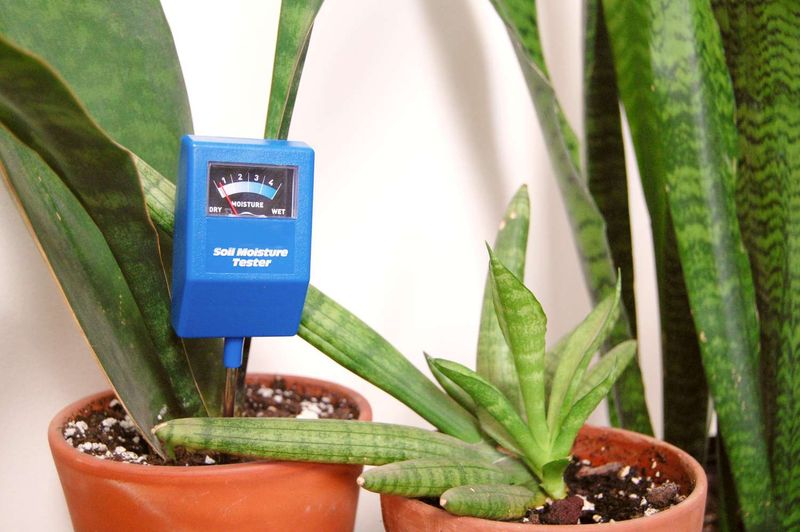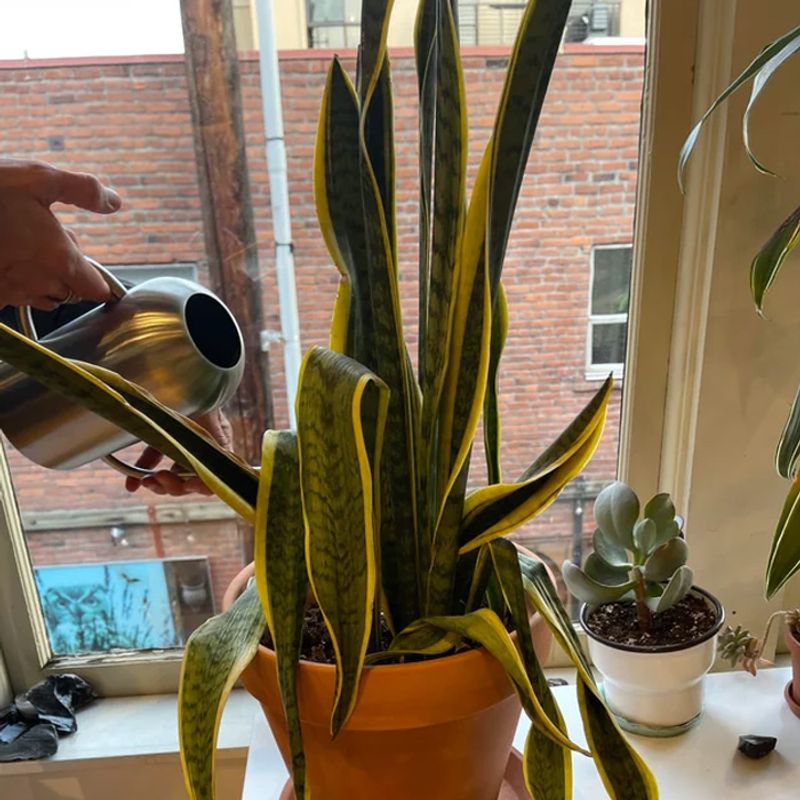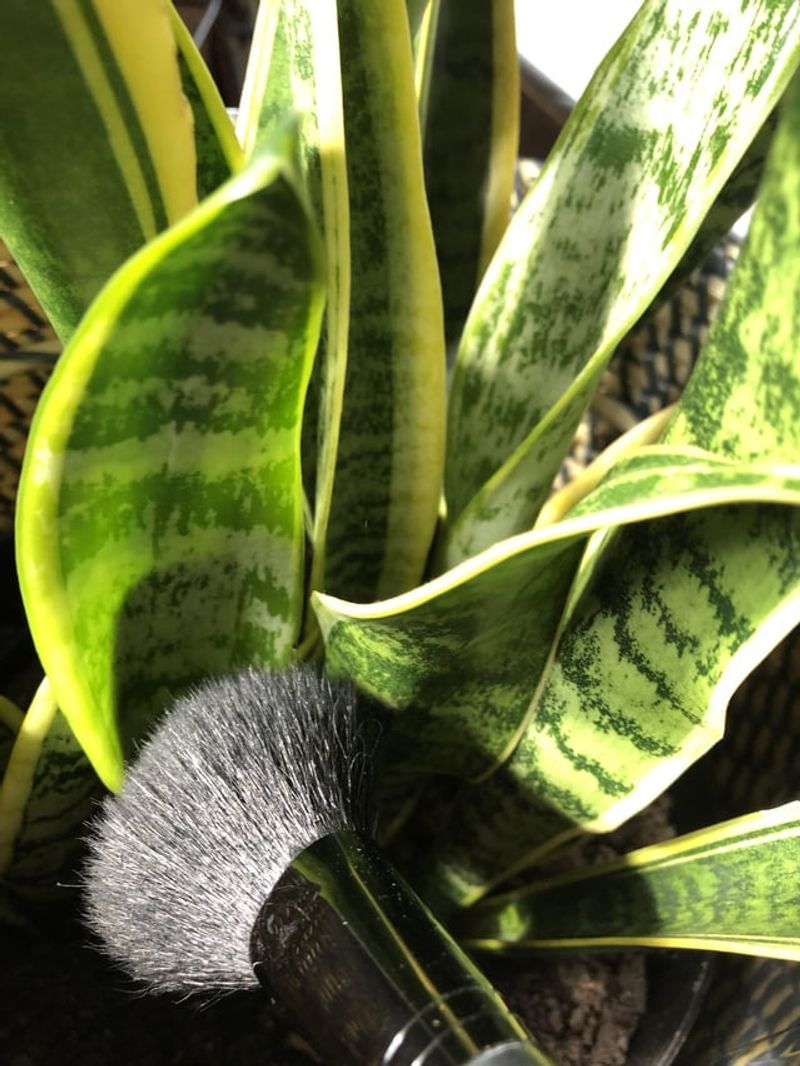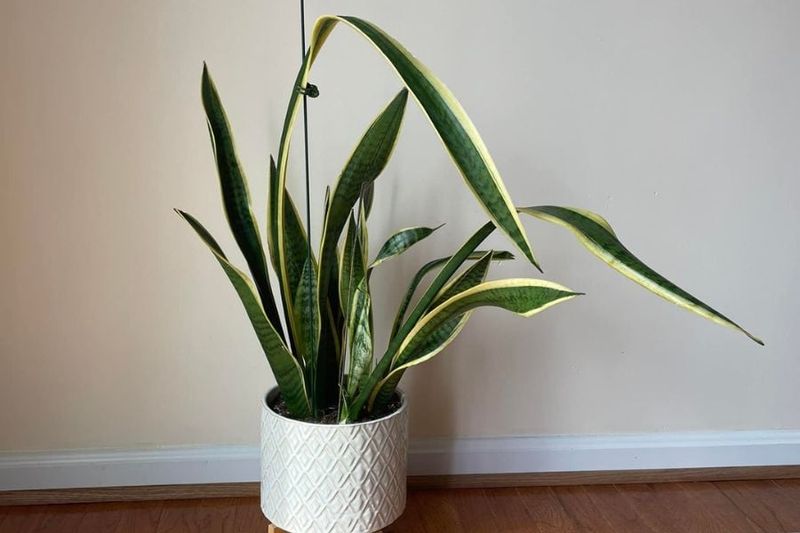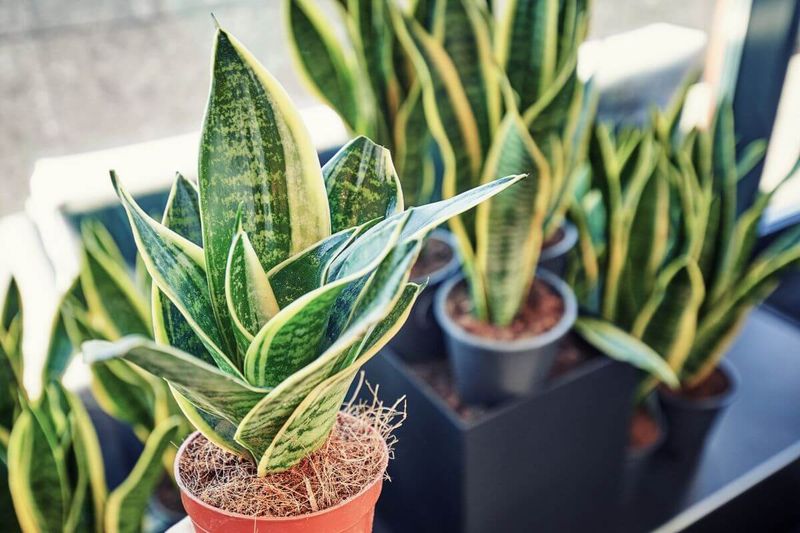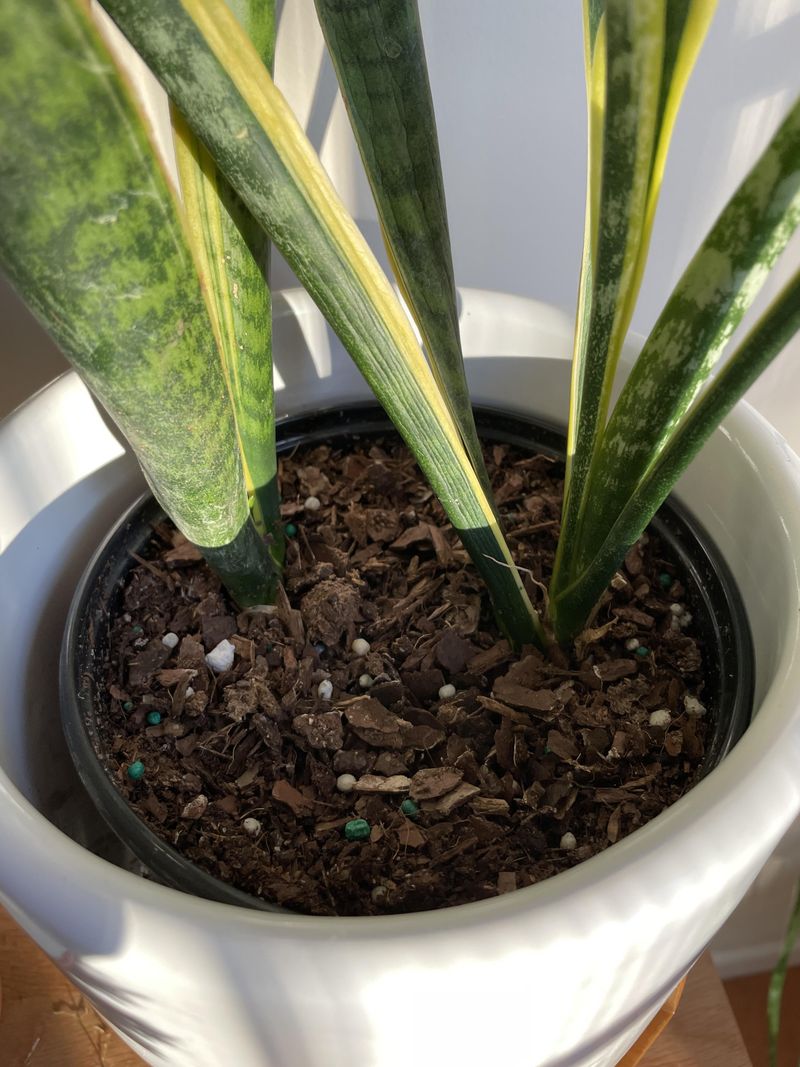Snake plants are famously tough, but that doesn’t mean they can’t flourish with a touch of extra care. If yours feels a bit sparse or lacks those bold, upright leaves, there’s plenty you can do.
A few simple tweaks can bring stunning results. Go easy on watering—less is more with these desert natives. Bright, indirect light helps them grow tall and strong, while a well-draining soil mix prevents root rot. And don’t forget to wipe their leaves occasionally to keep them photosynthesizing efficiently.
These tips come from years of trial and error with my own collection, so I know they work. A thriving snake plant isn’t just a pretty sight—it’s a testament to how small changes can make a big impact.
1. Let The Soil Fully Dry Out
Overwatering is the quickest way to kill these drought-tolerant beauties. I only water mine when the soil feels completely dry at least 2 inches down. This usually means watering just once every 2-3 weeks, depending on your home’s conditions.
During winter, I stretch this even longer – sometimes going a month between waterings. The roots strengthen when they have to search a little for moisture.
This approach prevents root rot and encourages the plant to develop a stronger root system, which ultimately supports fuller, taller growth. A moisture meter has been a game-changer for me in getting this right.
2. Rotate Your Plant Regularly
Plants naturally grow toward light sources, which can create lopsided growth if they’re always facing the same direction. Every week or two, I give my snake plants a quarter turn to ensure even exposure.
This simple habit prevents leaning and encourages upright, balanced growth. You’ll notice the difference within a month or two – leaves will stand taller rather than stretching sideways.
In my apartment’s north-facing window, this trick transformed my formerly tilted snake plant into a perfectly symmetrical specimen. The outer leaves especially benefit from this rotation schedule.
3. Provide Bright Indirect Light
While snake plants tolerate low light, they won’t thrive there. Mine exploded with new growth when I moved it from a dark corner to a spot with bright, filtered light. The difference was remarkable within just a couple months.
A few feet back from a south or west-facing window creates that sweet spot – enough light to power growth without the harsh direct rays that can scorch leaves. East-facing windows work beautifully too.
If your space lacks natural light, consider a grow light positioned about 12 inches away. I use a simple clip-on LED grow light in my darker rooms, running it for about 8 hours daily.
4. Choose The Right Pot Depth
Snake plants develop extensive root systems that prefer depth over width. I’ve found that slightly taller pots encourage taller growth, while wider, shallower containers promote fuller, more clustered leaves.
A pot that’s 1-2 inches deeper than the root ball gives room for downward growth while maintaining stability. Terra cotta works particularly well as it wicks away excess moisture.
When I repotted my snake plant from a wide, shallow dish to a deeper container, the new leaves that emerged reached nearly a foot taller than the previous ones. The plant seemed to appreciate having that extra vertical space below.
5. Use Well-Draining Soil Mix
Regular potting soil holds too much moisture for snake plants. I mix equal parts cactus soil, regular potting mix, and perlite to create the perfect balance of nutrition and drainage. This combination prevents the soggy conditions that lead to root rot.
The coarse texture allows oxygen to reach the roots while excess water drains away quickly. You’ll notice healthier growth within weeks of switching to this mix.
I learned this lesson the hard way after losing a snake plant to root rot. Since switching to this custom blend, my plants develop stronger roots that support taller, more robust leaves. The difference is truly night and day.
6. Divide And Conquer For Fullness
When my snake plant started looking sparse, I pulled it from its pot and gently separated the rhizomes. Each section with at least one healthy leaf and some roots became a new plant. I replanted several sections together in the original pot.
This division technique creates an instantly fuller appearance while encouraging new growth points. The plant responds to this disturbance by producing fresh leaves from multiple points.
Within three months, my formerly leggy plant transformed into a lush cluster with new growth emerging from all sides. This approach works best during spring or early summer when the plant is naturally in a growth phase.
7. Fertilize Sparingly But Strategically
Snake plants don’t need much feeding, but a little goes a long way. I apply a balanced, water-soluble fertilizer diluted to half-strength just twice during the growing season – once in early spring and once in midsummer.
This minimal approach provides necessary nutrients without the salt buildup that can damage roots. I’ve found that over-fertilizing actually stunts growth rather than enhancing it.
The results aren’t immediate but become evident in the plant’s overall vigor. After implementing this feeding schedule, my snake plant produced three new leaves that grew taller and thicker than any previous growth. Less really is more with these efficient plants.
8. Prune Damaged Leaves At The Base
Those brown-tipped or floppy outer leaves aren’t doing your plant any favors. I remove damaged leaves entirely by cutting them at the soil line with clean, sharp scissors. This redirects energy to new growth rather than repair.
Make clean cuts as close to the soil as possible without disturbing neighboring leaves. This pruning stimulates the plant to produce fresh, upright growth.
The first time I did this, I was nervous about removing too much, but within weeks, new pups emerged to fill the space. My snake plant looked temporarily sparser but quickly rebounded with healthier, more uniform growth that significantly improved its appearance.
9. Clean Leaves Monthly
Dust-covered leaves can’t photosynthesize efficiently. I wipe my snake plant’s leaves once a month with a damp microfiber cloth, supporting each leaf with one hand while gently cleaning with the other. This simple maintenance makes a surprising difference in growth rate.
The cleaning removes dust and potential pests while allowing the leaves to absorb more light. I avoid leaf-shining products that can clog the plant’s pores.
After three months of regular cleaning, I noticed my plant’s color deepened and new growth appeared more frequently. This task takes just five minutes but yields impressive results for overall plant health and appearance.
10. Maintain Warm, Stable Temperatures
Snake plants prefer consistency in their environment. I keep mine in areas that stay between 65-85°F year-round, away from drafty windows, air conditioning vents, and heaters that cause temperature fluctuations.
These temperature swings can shock the plant and slow growth. In winter, I move my plants a few inches farther from windows to avoid cold drafts.
The stability encourages steady, reliable growth. When I moved a struggling snake plant away from an AC vent, it responded with three new leaves within weeks. Sometimes the simplest adjustments make the biggest difference in encouraging taller, healthier growth.
11. Support Extremely Tall Leaves
Sometimes success brings new challenges – like when leaves grow so tall they start to flop over! I use bamboo stakes placed strategically near (but not through) the root system to support exceptionally tall growth. Secure the leaf with soft plant ties or twine.
This support allows leaves to continue growing upward without bending or breaking. The stakes should be nearly invisible when positioned correctly among the leaves.
I discovered this technique when my tallest snake plant reached nearly four feet and began to lean. The support not only prevented damage but also encouraged the leaf to grow another six inches once it had proper support. The stakes can be removed once the leaf strengthens.
12. Give Them Some Breathing Room
While snake plants tolerate being somewhat rootbound, extreme crowding stunts growth. I check my plants annually by gently removing them from their pots to inspect the roots. If they’re circling tightly with little soil visible, it’s time for a slightly larger home.
When repotting, I choose a container just 1-2 inches wider than the current one. This provides enough fresh soil and space without overwhelming the plant with too much excess soil that can retain moisture.
The growth spurt after repotting an overcrowded snake plant can be dramatic. My oldest plant put out five new leaves within two months of being moved to a more spacious pot after years of confinement.
13. Propagate Leaf Cuttings For Fullness
To create a fuller-looking plant without waiting years, I take 4-inch leaf cuttings and plant them directly back into the original pot. Remember which end was closest to the soil – that end goes down when replanting.
I insert these cuttings around the perimeter of the pot, leaving the original plant undisturbed in the center. This creates a multi-level effect with mature tall leaves surrounded by shorter new growth.
The cuttings take several months to root and begin growing, but the visual impact is worth the wait. My once-sparse snake plant now has a lovely cascading effect with leaves of varying heights creating a much fuller appearance.
14. Address Pests Immediately
Even resilient snake plants occasionally attract spider mites or mealybugs, which can severely impact growth if left unchecked. I inspect my plants weekly, paying special attention to leaf crevices and the soil surface where pests often hide.
At the first sign of trouble, I isolate the affected plant and treat it with insecticidal soap or neem oil, applied with a cotton swab for precision. Follow-up treatments every 7-10 days break the pest life cycle.
Catching an infestation early makes all the difference between a minor setback and a major problem. My largest snake plant almost succumbed to spider mites until I implemented this regular inspection routine and caught the next infestation within days.
15. Provide Moderate Humidity
While snake plants tolerate dry air, they grow more vigorously in moderate humidity between 40-50%. I avoid placing mine in extremely dry areas like near heating vents or in naturally humid spaces like bathrooms.
There’s no need for misting or humidifiers – grouping plants together naturally creates a microclimate with improved humidity. This subtle adjustment supports healthier growth without risking excess moisture on the leaves.
When I moved my snake plant from an isolated spot to a cluster with other houseplants, the new leaves emerged wider and more vibrant. The plant clearly appreciated the slightly more humid environment created by its green companions.
16. Avoid Frequent Relocation
Snake plants prefer consistency and often respond to moves with temporary growth pauses. I keep mine in one optimal spot rather than constantly repositioning them. When I must move them, I try to maintain similar light conditions.
This stability allows the plant to adapt fully to its environment and direct energy toward growth rather than acclimation. Even rotating for even growth should be done gently without dramatic changes.
After constantly moving a snake plant around my apartment, I finally gave it a permanent home in my living room. Within weeks, it produced its first new leaf in months – a clear sign that it appreciated the stable conditions.
17. Bottom Water When Possible
Pouring water directly onto soil can cause compaction over time. Instead, I place my snake plants in a few inches of water for about 15-20 minutes, allowing them to drink from the bottom up through the drainage holes.
This technique encourages deeper root growth as the roots reach downward toward the moisture. It also prevents water from sitting in the leaf rosettes, which can lead to rot.
I’ve noticed significantly stronger root systems in my bottom-watered plants compared to top-watered ones. The roots appear more extensive and better distributed throughout the pot, which naturally supports taller, more stable growth over time.
18. Practice Seasonal Care Adjustments
Snake plants have distinct seasonal needs that affect their growth patterns. During spring and summer (the growing season), I water more frequently and position them for maximum indirect light. In fall and winter, I cut back on water and fertilizer entirely.
This seasonal approach respects the plant’s natural growth cycle. Even indoors, snake plants sense seasonal changes through light duration and intensity.
Following this rhythm has resulted in predictable growth spurts each spring. My oldest snake plant reliably produces 3-4 new leaves every April through June, followed by a rest period. Working with these natural cycles rather than fighting them leads to healthier, more sustainable growth.


